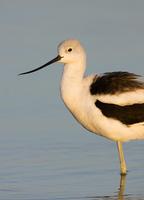|
| Query: avocet | Result: 2nd of 87 | |
American Avocet, winter plumage male

| Resolution: 467x650
File Size: 30829 Bytes
Upload Date: 2008:02:17 22:24:13
|
BIRDS AS ART BIRDS AS ART BULLETIN 210
Merritt Island,
I had just pulled up to a huge flock of White Pelicans doing
their group feeding thing in a pool right next to the road
when a car pulled up behind me. The guy got out with an
intermediate telephoto lens and the birds all flew away, about
two miles away… And a few days ago at DeSoto I had a group of
five American Avocets right outside my car. Another
photographer left his vehicle, walked several hundred yards
towards my position with his big lens on his shoulder, and
scared all the birds away. You gotta love it. When
the inevitable occurs, it is fine—if you are comfortable doing
so—to let the offender know politely that their behavior was
inappropriate. No matter how egregious the offense,
screaming or cursing will not help the situation at all.
It goes without saying that we all must follow the rules when
working in controlled areas. If the signs say “Stay on
the Path,” then we must stay on the path. If the sign
says “Area Closed,” then we must not enter. To do
otherwise gives all photographers a black mark. (At
present, because of the actions of a relatively few, many
refuge managers consider all photographers criminals.)
If you encounter another photographer breaking the rules or
you might consider informing them as politely as possible that
their behavior is improper. If the other photographer
ignores your request, it is best to move on. You might
consider jotting down a description or better yet, a license
plate number, and letting the authorities know what you
observed. When doing so you are—in my opinion—obligated
to leave your contact information.
The suggestions above are only guidelines (but they are based
on 23 years of field experience). There are surely lots
of grey areas and close calls. At all times it is best
to obey the posted rules, to be considerate of others and the
subjects that they are photographing, and to remember that no
image is worth disregarding the welfare of the creature that
we are photographing.
American Avocet, winter plumage male, Fort DeSoto Park, St.
Petersburg, FL
Image copyright 2006: Arthur Morris/BIRDS AS ART
Canon 600mm f/4 L IS L lens with 2X II TC and EOS-1D Mark IIN.
ISO 400.
Evaluative Metering +2/3 stop: 1/320 sec. at f/10. Image made
from vehicle with rig on BLUBB: (
http://www.birdsasart.com/blubb.htm
I was pretty much amazed when an experienced photographer who
should have known better left his vehicle and walked about 200
yards towards the spot where I was photographing a group of
five rather skittish avocets in late afternoon light. It
seemed as if his only purpose was to flush not only the
avocets but the rest of the gulls and shorebirds. He
succeeded. Note that the front end vertical composition that I
used here is one of my favorites. You can learn a ton
about advanced composition and image design in “ The Art of
Bird Photography II” (936 pages on CD only):
|
^o^
Animal Pictures Archive for smart phones
^o^
|
|